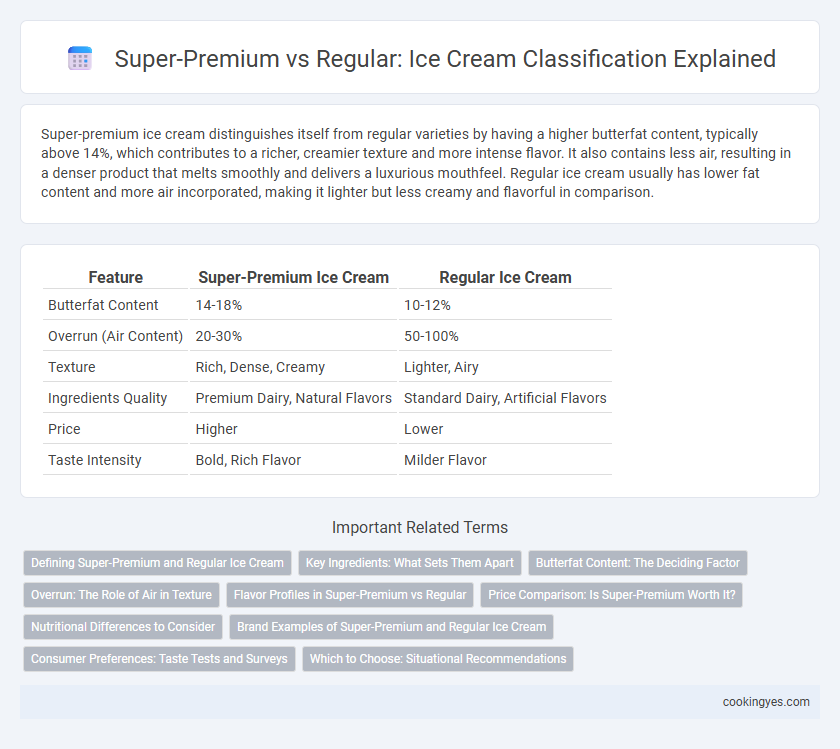Super-premium ice cream distinguishes itself from regular varieties by having a higher butterfat content, typically above 14%, which contributes to a richer, creamier texture and more intense flavor. It also contains less air, resulting in a denser product that melts smoothly and delivers a luxurious mouthfeel. Regular ice cream usually has lower fat content and more air incorporated, making it lighter but less creamy and flavorful in comparison.
Table of Comparison
| Feature | Super-Premium Ice Cream | Regular Ice Cream |
|---|---|---|
| Butterfat Content | 14-18% | 10-12% |
| Overrun (Air Content) | 20-30% | 50-100% |
| Texture | Rich, Dense, Creamy | Lighter, Airy |
| Ingredients Quality | Premium Dairy, Natural Flavors | Standard Dairy, Artificial Flavors |
| Price | Higher | Lower |
| Taste Intensity | Bold, Rich Flavor | Milder Flavor |
Defining Super-Premium and Regular Ice Cream
Super-premium ice cream contains higher butterfat content, typically ranging from 14% to 18%, and lower overrun, resulting in a denser, creamier texture compared to regular ice cream, which usually has 10% to 12% butterfat and higher overrun. Ingredients in super-premium varieties are often richer and more natural, emphasizing quality flavors and premium dairy elements. Regular ice cream tends to be lighter and airier due to greater air incorporation, making it less expensive but less creamy than super-premium options.
Key Ingredients: What Sets Them Apart
Super-premium ice cream contains a higher butterfat content, often ranging from 14% to 18%, compared to regular ice cream's 10% to 12%, resulting in a creamier texture and richer flavor. The use of less air during churning, known as overrun, typically below 25% in super-premium, enhances density and smoothness, contrasting with the lighter and airier texture of regular varieties. Premium ingredients like natural vanilla beans, real cream, and fresh fruits differentiate super-premium ice cream, whereas regular ice cream may rely more on artificial flavors and stabilizers.
Butterfat Content: The Deciding Factor
Super-premium ice cream is distinguished by its high butterfat content, typically between 14% and 18%, which enhances creaminess and richness compared to regular ice cream containing 10% to 12% butterfat. This increased butterfat level results in a denser texture and more intense flavor profile, offering a luxurious mouthfeel that appeals to discerning consumers. Manufacturers use this higher butterfat content as a key metric to classify and market super-premium ice creams, emphasizing quality and indulgence over mass production.
Overrun: The Role of Air in Texture
Super-premium ice cream typically contains an overrun of 20-30%, meaning less air is incorporated during churning, resulting in a denser and creamier texture compared to regular ice cream with overruns up to 100%. The reduced air content enhances the mouthfeel, richness, and flavor intensity, making super-premium varieties more indulgent and satisfying. Overrun plays a critical role in ice cream classification, directly influencing texture, weight, and overall consumer perception of quality.
Flavor Profiles in Super-Premium vs Regular
Super-premium ice cream offers intense and complex flavor profiles due to higher butterfat content, typically above 14%, and lower overrun, which concentrates the taste. Regular ice cream, with 10-12% butterfat and higher air incorporation, delivers milder, less rich flavors, often relying on added artificial flavorings. The richness and creaminess of super-premium varieties create a more indulgent and pronounced sensory experience compared to the lighter, more subtle taste of regular ice cream.
Price Comparison: Is Super-Premium Worth It?
Super-premium ice cream typically costs 1.5 to 2 times more than regular ice cream, reflecting higher-quality ingredients and denser texture. While super-premium options offer richer flavor and creamier consistency due to lower overrun and higher fat content, regular ice cream remains a budget-friendly choice for everyday indulgence. Consumers seeking superior taste and texture may find super-premium ice cream worth the premium price, especially for special occasions.
Nutritional Differences to Consider
Super-premium ice cream typically contains higher fat content, often ranging from 14-18%, compared to regular ice cream's 10-12%, resulting in a richer texture and creamier mouthfeel. The increased fat not only enhances flavor intensity but also contributes to higher calorie content per serving, which can impact dietary considerations. Additionally, super-premium varieties may have less air (overrun), making them denser and more nutrient-concentrated than regular ice creams.
Brand Examples of Super-Premium and Regular Ice Cream
Super-premium ice cream brands such as Haagen-Dazs, Ben & Jerry's, and Talenti emphasize rich ingredients, higher fat content, and minimal air incorporation, offering creamier and more intense flavors. Regular ice cream brands like Breyers, Blue Bell, and Dreyer's focus on affordability and wider distribution, typically containing lower butterfat percentages and more air to maintain a lighter texture. Understanding brand differentiation in super-premium and regular ice cream categories helps consumers choose based on taste intensity, texture, and price sensitivity.
Consumer Preferences: Taste Tests and Surveys
Super-premium ice cream consistently ranks higher in consumer taste tests due to its richer texture and intense flavor profiles, attributed to higher butterfat content and superior ingredients. Surveys reveal that consumers willing to pay a premium prioritize creamy mouthfeel and unique flavors, while regular ice cream appeals to budget-conscious buyers favoring basic, familiar tastes. Market research indicates growing demand for artisanal and indulgent options within the super-premium segment, reflecting evolving consumer preferences toward quality over quantity.
Which to Choose: Situational Recommendations
Super-premium ice cream boasts higher butterfat content, typically 14-18%, and lower overrun, resulting in a denser, creamier texture ideal for indulgent desserts or special occasions. Regular ice cream, with 10-12% butterfat and higher air content, offers a lighter, more budget-friendly option suitable for everyday enjoyment or large gatherings. Choose super-premium for rich flavor and luxury, while regular serves well for casual consumption and cost-effective portions.
Super-premium vs Regular for ice cream classification Infographic

 cookingyes.com
cookingyes.com